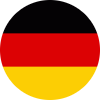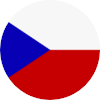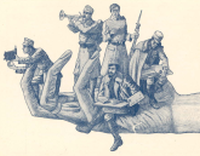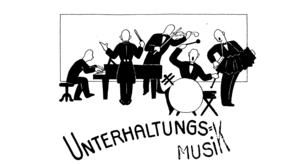Circulating exhibitions
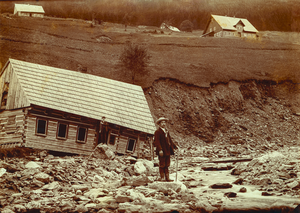
Mensch, Natur und ihre Katastrophen
Historische Fotografien aus Böhmen aus der Sammlung Scheufler
Sudetendeutsches Haus, Hochstr. 8, München
Die Ausstellung mit historischen Fotografien aus der Sammlung Scheufler thematisiert Naturkatastrophen in den böhmischen Ländern. Fast alle Aufnahmen stammen aus der Zeit der k. u. k. Monarchie im Zeitraum 1870–1918. Renommierte Fotografen ihrer Zeit wie Rudolf Bruner-Dvořák oder František Krátký fingen die Folgen der Kraft von Wind, Wasser oder Feuer in verschiedenen böhmischen Regionen ein. Die durch Hochwasser 1890 partiell eingestürzte Prager Karlsbrücke ist ebenso zu sehen wie von Erdrutschen beschädigte Häuser im Riesengebirge oder vom Tagebau verursachte Schäden in Brüx/Most. Die Rolle des Menschen wird dabei kritisch gewürdigt, und es wird im Kontext des aktuellen Klimawandels zum Nachdenken angeregt.
Ansprechpartner
Dr. Wolfgang Schwarz, schwarz@stifterverein.de, Telefon +49 89/62 27 16-35
Technische Angaben
Eine Einführungstafel 200 x 140 cm, 60 Fotografien in den Größen (30 x 40 sowie 30 x 30, wegen Zuschneidnung manche leicht abweichend). Passpartous in den Größen 80 x 60 cm (ca. 40 Bilder) sowie 60 x 50 cm (ca. 20 Bilder). Eine Entleihe der Bildrahmen ist im Ausnahmefall möglich, die Fotos können jedoch auch von den Passpartous abgelöst werden und an Passpartous anderer Größen angebracht werden.
Sprache
Die Ausstellung ist durchgehend deutsch-tschechisch (Bildlegenden, Einführungstafel).
Werbematerial, Katalog
Plakatvorlagen sind vorhanden. Ein Katalog zu der Ausstellung existiert nicht.
Ausleihbedingungen und Kosten
Es wird keine Ausleihgebühr erhoben. Für die Ausleihe wird eine Vereinbarung über den Verleih von Ausstellungen zwischen dem Kulturreferat und dem Entleiher abgeschlossen. Die Organisation der Anlieferung bzw. der Rückgabe der Ausstellung (evtl. auch Weitertransport an den nächsten Ausstellungsort) wird gesondert geregelt. Die dafür anfallenden Kosten übernimmt in der Regel der Entleiher, Sondervereinbarungen sind jedoch möglich. Der Entleiher verpflichtet sich, im Rahmen seiner Öffentlichkeitsarbeit auf die Autorschaft des Kulturreferats für die böhmischen Länder im Adalbert Stifter Verein hinzuweisen.

Great Czechs
Between Language, Nation and State 1800–1945
The biographies of 15 famous Czech personalities with emphasis on their relationship to the German language and culture and the Habsburg monarchy are presented. The Czechs portrayed in the exhibition are: Tomáš Baťa, Karel Čapek, Ema Destinová (Emmy Destinn), Antonín Dvořák, Jaroslav Hašek, Leoš Janáček, Josef Jungmann, František Křižík, Josef Lada, Karel Hynek Mácha, Tomáš Garrigue Masaryk, Alfons Mucha, Božena Němcová, František Palacký, Bedřich Smetana.
Contact
Dr. Wolfgang Schwarz, schwarz@stifterverein.de, Phone number +49 89/62 27 16-35
Practical information
19 freestanding roll-up banners, 100 cm wide, 215 cm high
Text
The exhibition is entirely in German and Czech. Every banner includes a German and a Czech version.
Promotional material, catalogue
Flyer and poster templates are available. An accompanying publication (only in German) is available for purchase.
Terms and costs
Renting the exhibition is free of charge. A contract is signed between the ASV and the borrower. The delivery and return of the exhibition (potentially also transport to the next place where the exhibition is to be held) is planned individually. Transport costs are usually covered by the borrower, however special arrangements can be made. The borrower should make clear that the author of the exhibition is the cultural manager for the Czech Lands of the Adalbert Stifter Association. It is recommended to offer the accompanying publications for sale for the duration of the exhibition. Transport
The exhibition can be transported in an average-sized car (usually with the back seats folded down).
Liability and insurance
The borrower is liable for any damage that may occur between picking up the exhibition and returning it or passing it on. The borrower can insure the exhibition for this period. The insurance value of each roll-up banner is about €450.
Previous locations of the exhibition
The exhibition was first opened on 20 June 2017 at the Czech Centre in Munich. Other places where the exhibition has been shown include the German School in Prague (March 2017), the Science Library in Olomouc (April 2018), Lauf Castle (January-March 2019) and the University of Passau (May 2019).

Faded But Not Gone
A search for clues in the Bohemian Forest
These days relations between Germany and the Czech Republic are well set for the future. Yet their shared past was not free from conflict. Since 2017 a research team from institutions at the Universities of Regensburg, Passau, Prague and Ústí nad Labem, as well as the Cultural Manager for the Czech Lands for the Adalbert Stifter Association, have been working, with junior researchers in mind, on the topic of border/s between the Czech Republic and Bavaria in the context of a national and transnational culture of remembrance.
With this in mind, in October 2019 an excursion of students from the above-mentioned universities followed in the footsteps of the former German-speaking population of the Bohemian Forest. The participants each chose one of three photographs and wrote texts to accompany them. The bilingual German-Czech Exhibition, which is also available in digital format, shows old cemeteries, churches, remains of disappeared villages and newly established museums. It carefully transports us into a world of the past.
Head of excursions: Dr. Wolfgang Schwarz, the Cultural Manager for the Czech Lands for the Adalbert Stifter Association, doctoral student Mikuláš Zvánovec, Charles University Prague
Concept of the exhibition: Wolfgang Schwarz
The exhibition was sponsored by the Bavarian-Czech Academic Agency.
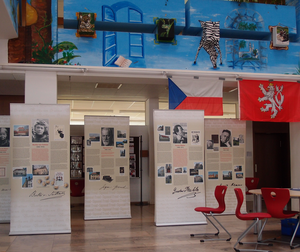
Born in Bohemia and Moravia – (un)known to us?
Twelve selected Biographies
The exhibition is about the origins of 12 prominent German-speaking personalities who came from the Czech Lands. Texts and photographs inform us of the legacy these people left behind and how they are viewed today. The following personalities are included: Adalbert Stifter, Johann Gregor Mendel, Marie von Ebner-Eschenbach, Bertha von Suttner, Sigmund Freud, Gustav Mahler, Karl Kraus, Rainer Maria Rilke, Ferdinand Porsche, Franz Kafka, Oskar Schindler, Otfried Preußler.
Contact
Dr. Wolfgang Schwarz, schwarz@stifterverein.de, Phone number +49 89/62 27 16-35
Practical information
14 freestanding roll-up banners, 100 cm wide, 215 cm high
Text
The exhibition is entirely in German and Czech. Every roll-up banner includes a German and a Czech version.
Promotional material, catalogue
Flyer and poster templates are available. An accompanying publication (a version with text and photos in German and a version without photos in Czech) can also be provided.
Terms and costs
Renting the exhibition is free of charge. A contract is signed between the ASV and the borrower. The delivery and return of the exhibition (potentially also transport to the next place where the exhibition is to be held) is planned individually. The transport is usually paid for by the borrower, although special arrangements can be made. The borrower should mention the author of the exhibition: the cultural manager for the Czech Lands of the Adalbert Stifter Association. It is recommended to offer the accompanying publications for sale for the duration of the exhibition.
Transport
The exhibition can be transported in an average-sized car (usually with the back seats folded down).
Liability and insurance
The borrower is liable for any damage that may occur between picking up of the exhibition and returning it or passing it on. The borrower can insurance the exhibition for this period. The insurance value of each roll-up banner is about €350.
Previous locations of the exhibition
The exhibition has been in over 40 places in Germany, the Czech Republic and Austria. For example, the Bavarian State Library in Munich, the Czech Centre Berlin, the City Library of Bremen, the Universities of Regensburg, Passau and Salzburg, the Martin-Opitz-Library in Herne, the Academic Library in Olomouc, the Library of South Bohemia in Budweis, the Prague Literature House of German-speaking writers, and the Technical University in Jihlava. You can find a complete list of the places where the exhibition has been shown here >>
Here you can find a complete list of the places where the exhibition has been shown
Muses to the front!
Writers and Artists Working for Austro-Hungarian War Propaganda
„Inter arma silent musae“. The famous saying about the silence of the muses during war is based on the ideal of art as a product only of the human mind, untouched by blood and violence. In reality, no battles were ever fought without writers and artists having their say about them.
The magnitude and consequences of the First World War exceeded those of all previous wars; even at the time people called it the „Great War“. The number of countries involved, the number of soldiers fighting on different fronts, the millions of victims and the extent of the destruction justify this term. Furthermore, military technology that had not been used before was used for the first time: gas, aeroplanes, armoured combat vehicles, heavy artillery, but also war propaganda as a way of influencing public opinion and thus fighting „by other means“.
For propaganda purposes a „War Press Quarter“ (KPQ) was founded as a special facility of the High Command of the Austro-Hungarian army, which provided the press with reports on the war. An particularly large number of journalists and artists joined the KPQ, including well-known writers such as Roda Roda, Egon Erwin Kisch, Leo Perutz, Richard A. Bermann (Arnold Höllriegel), Ferenc Molnár, Robert Michel, Franz Werfel or artists such as Oskar Laske, Oskar Kokoschka, Ferdinand Staeger, Ludwig Hesshaimer, Albin Egger-Lienz. Among other things a photography and film unit was set up to report on the war, as well as a theatre and music department and even a censorship unit, which monitored all information and decided what was to be published.
At the same time, a „literary group“ was created in the Vienna War Archives, which documented the war and promoted the cause of the Empire through journalism. Franz Theodor Csokor, Rudolf Hans Bartsch, Franz Karl Ginzkey, Felix Salten, Stefan Zweig, Rainer Maria Rilke, Alfred Polgar (Polak) worked in this group.
Both the KPQ and the „Literary Group“ offered many journalists, writers and artists the opportunity to avoid military service and to take on a job in making war propaganda whether with pen, brush or camera.
The exhibition and the accompanying publication show the deliberate or unconscious part literature and art played in the First World War. It describes both the wavering of artists and intellectuals between patriotism and pacifism as well as their voluntary engagement with the war. Many different attitudes towards war become apparent when comparing the different personalities, but diverse phases and changes can also be observed within individual biographies.
Some of the writers and artists serving the Austro-Hungarian war propaganda came from Bohemia and Moravia; special attention is paid to these in the exhibition.
Contact
Anna Knechtel M.A., knechtel@stifterverein.de, Phone number +49 89/62 27 16-30
Practical information
35 panels in glass frames measuring 80 x 60 cm (portrait format only)
Text
The text on the panels is in German. The text is also available in Czech, Slovenian, English, Italian and Hungarian.
Promotional material
Press releases
Accompanying publication in 2 volumes, ed. by Jozo Džambo (Part 1: Articles, Part 2: Documentation)
Terms and costs
The exhibition can be borrowed after consulting a representative of the ASV and signing an agreement on the rental of the exhibition. No fees apply. Usually, the exhibition is to be collected in Munich and returned to Munich after it has ended.
The organizer pays for transport, insurance, posters and invitations, the assembly and dismantling of the exhibition, as well as travel costs and accommodation costs for an employee of the Adalbert Stifter Association (who gives an introductory lecture). Special agreements may apply after consultation with the ASV and then form a part of the agreement on the rental of the exhibition.
Transport
The exhibition posters are framed. Sufficient upholstery material is necessary to prevent the glass from breaking: blankets, wood shavings or cardboard, cords and expandable bands for securing.
Previous locations of the exhibition
Since it was first opened on May 19, 2003 in the Alfred Kubin Gallery in the Sudeten-German-House, Munich, the exhibition has been shown in:
Linz, Prague, Brno and Slavkov (2004)
Innsbruck and Kobarid (Slovenia) (2005)
Ljubljana (Slovenia) (2006)
Budapest, Pécs (Hungary) and Székesfehérvár (Hungary) (2008)
Graz, Vienna (2009)
St. Michael/Burgenland (2010)
Kaufbeuren-Neugablonz, Jizera Mountains Museum (2012)
Plankstetten Abbey (Upper Palatinate) und Dresden (2014)
Düsseldorf, Gerhard Hauptmann House (2016)
Speinshart Monastery (2019)
Posters from the Terezín Ghetto
Culture and Art in Terezín 1941-45
The exhibition displays posters made by prisoners of the so-called Terezín Ghetto, which was in reality a concentration camp, inviting people to operas, cabarets, classical and modern concerts, choir concerts and academic talks. Although they languished in inhumane conditions and although their situation was without hope, the prisoners found time and strength to get involved in cultural activities. In this way, face to face with death, they showed their protest against dehumanisation. For the first time posters in German from the so-called Herman Collection of Terezín could be exhibited, with the help of the historian Dr. Rudolf Wlaschek, Mönchengladbach.
Contact
Anna Knechtel M.A.
Form and measurements of the exhibition pieces
35 unframed carton-panels, 80 x 60 cm with affixed coloured reproductions, including 4 text-panels
Labelling
The labels are in German, with short explanations for individual posters
Advertising material
Press releases
Recommended literature: Wlaschek, Rudolf: Art and Culture in Terezín
Introductory speech by a member of the Adalbert Stifter Association
The digital exhibition
Previous locations of the exhibitions
Since the opening of the exhibition on the 27th February 2003 in the Alfred Kubin Gallery in the Sudeten-German-House, Munich, the exhibition has been in:
Furth im Wald 2003
Herrsching/Ammersee 2004
Merzdorf-Memmelsdorf/Lower Franconia, the Old Synagogue 2009
Transport
The exhibition-posters are stored in several big-format cardboard folders and can be transported horizontally.
Insurance value
Each board € 50
Renting conditions
The exhibition can be hired following consultation with a representative of the Adalbert Stifter Association and the signing of an agreement on the renting of the exhibition. Usually, the exhibition can be picked up in Munich and brough back to Munich when it is over. The person hiring the exhibition must insure it for this entire period. The insurance value is €1,700.
Costs
Renting the exhibition is free of charge. The expenses for transport, insurance, event-posters and invitations, the assembling and dismantling of the exhibition, as well as the potential travel costs and accommodation costs of a member of the Adalbert Stifter Association (for the introductory speech) are the responsibility of the organisers. Special arrangements apply after consultation with the Adalbert Stifter Association and after their inclusion in the contract on the renting of the exhibition.
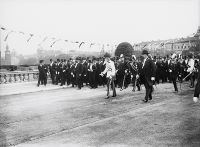
Emperor Franz Joseph and Franz Ferdinand
Photographs by Rudolf Bruner-Dvořák from the Scheufler Collection
Rudolf Bruner-Dvořák (1864-1921) was the court-photographer of Franz Ferdinand, and a pioneer in photographic reporting for magazines. His photographs show the heir to the throne Franz Ferdinand and Emperor Franz Joseph manoeuvring, on hunting excursions, visiting Bohemia or on recreational vacations in St. Moritz. The photographs come from Pavel Scheufler’s, a Czech historian of photography, substantial collection. His photo archive encompasses over 30 000 photo positives and negatives from the time of the Habsburg monarchy.
The frames for the exhibition must be available on site. The exhibition can also be shown in a reduced version.
The exhibition, created by Pavel Scheufler and the Cultural Manager for the Czech Lands, was shown in the Sudeten German House in Munich from June 13th to June 25th, 2014.
Measurements:
5 x mounted photograph with label, size 65 x 80 cm
46 x mounted photograph with label, size 50 x 70 cm
1 x mounted introductory text to the exhibition, 50 x 70 cm
Contact:
Dr. Wolfgang Schwarz
Kulturreferent für die böhmischen Länder
Tel. 0879 622 716 35
